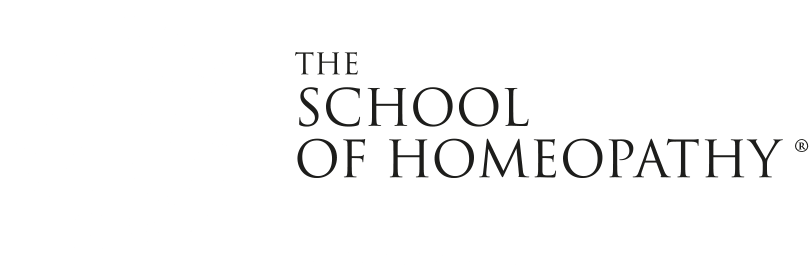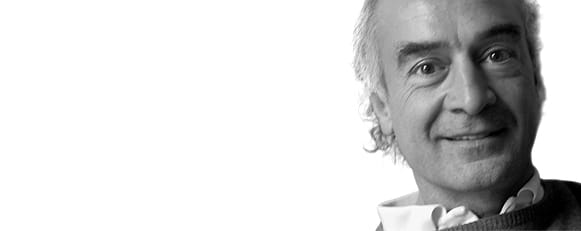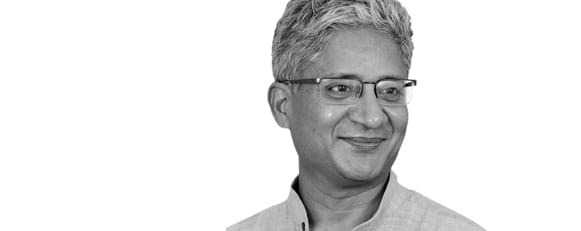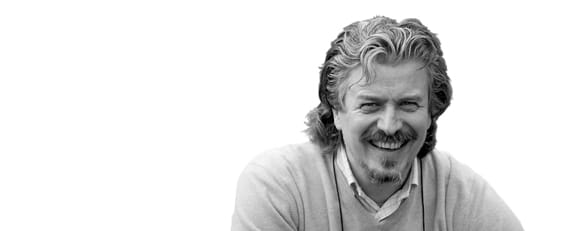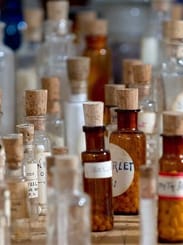
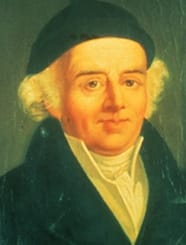
Aphorism 201-210
§ 201 Fifth Edition
It is evident that man’s vital force, when encumbered with a chronic disease which it is unable to overcome by its own powers, adopts the plan of developing a local malady on some external part, solely for this object, that by making and keeping in a diseased state this part which is not indispensable to human life, it may thereby silence the internal disease, which otherwise threatens to destroy the vital organs (and to deprive the patient of life), and that it may thereby, so to speak, transfer the internal disease to the vicarious local affection and, as it were, draw it thither. The presence of the local affection thus silences, for a time, the internal disease, though without being able either to cure it or to diminish it materially.1 The local affection, however, is never anything else than a part of the general disease, but a part of it increased all in one direction by the organic vital force, and transferred to a less dangerous (external) part of the body, in order to allay the internal ailment. But (as has been said) by this local symptom that silences the internal disease, so far from anything being gained by the vital force towards diminishing or curing the whole malady, the internal disease, on the contrary, continues, in spite of it, gradually to increase and Nature is constrained to enlarge and aggravate the local symptom always more and more, in order that it may still suffice as a substitute for the increased internal disease and may still keep it under. Old ulcers on the legs get worse as long as the internal psora is uncured, the chancre enlarges as long as the internal syphilis remains uncured, just as the general internal disease continues to increase as time goes on.
1 The issues of the old-school do something similar; as artificial ulcers on external parts, they silence some internal chronic diseases, but only for a short time, without being able to cure them; but, on the other hand, they weaken and destroy the general health much more than is done by most of the metastases effected by the instinctive vital force.
§ 201 Sixth Edition
It is evident that man’s vital force, when encumbered with a chronic disease which it is unable to overcome by its own powers instinctively, adopts the plan of developing a local malady on some external part, solely for this object, that by making and keeping in a diseased state this part which is not indispensable to human life, it may thereby silence the internal disease, which otherwise threatens to destroy the vital organs (and to deprive the patient of life), and that it may thereby, so to speak, transfer the internal disease to the vicarious local affection and, as it were, draw it thither. The presence of the local affection thus silences, for a time, the internal disease, though without being able either to cure it or to diminish it materially.1 The local affection, however, is never anything else than a part of the general disease, but a part of it increased all in one direction by the organic vital force, and transferred to a less dangerous (external) part of the body, in order to allay the internal ailment. But (as has been said) by this local symptom that silences the internal disease, so far from anything being gained by the vital force towards diminishing or curing the whole malady, the internal disease, on the contrary, continues, in spite of it, gradually to increase and Nature is constrained to enlarge and aggravate the local symptom always more and more, in order that it may still suffice as a substitute for the increased internal disease and may still keep it under. Old ulcers on the legs get worse as long as the internal psora is uncured, the chancre enlarges as long as the internal syphilis remains uncured, the fig warts increased and grow while the sycosis is not cured whereby the latter is rendered more and more difficult to cure, just as the general internal disease continues to increase as time goes on.
1 The issues of the old-school do something similar; as artificial ulcers on external parts, they silence some internal chronic diseases, but only for a short time, as long as they cause a painful irritation to which the sick organism is not used, without being able to cure them; but, on the other hand, they weaken and destroy the general health much more than is done by most of the metastases effected by the instinctive vital force.
§ 202
If the old-school physician should now destroy the local symptom by the topical application of external remedies, under the belief that he thereby cures the whole disease, Nature makes up for its loss by rousing the internal malady and the other symptoms that previously existed in a latent state side by side with the local affection; that is to say, she increases the internal disease. When this occurs it is usual to say, though incorrectly that the local affection has been driven back into the system or upon the nerves by the external remedies.
§ 203
Every external treatment of such local symptoms, the object of which is to remove them from the surface of the body, while the internal miasmatic disease is left uncured, as, for instance, driving off the skin the psoric eruption by all sorts of ointments, burning away the chancre by caustics and destroying the condylomata on their seat by the knife, the ligature or the actual cautery; this pernicious external mode of treatment, hitherto so universally practised, has been the most prolific source of all the innumerable named or unnamed chronic maladies under which mankind groans; it is one of the most criminal procedures the medical world can be guilty of, and yet it has hitherto been the one generally adopted, and taught from the professional chairs as the only one.1
1 For any medicines that might at the same time be given internally served but to aggravate the malady, as these remedies possessed no specific power of curing the whole disease, but assailed the organism, weakened it and inflicted on it, in addition, other chronic medicinal diseases.
§ 204 Fifth Edition
If we deduct all chronic affections, ailments and diseases that depend on a persistent unhealthy mode of living, (§ 77) as also those innumerable medicinal maladies (v. § 74) caused by the irrational, persistent, harassing and pernicious treatment of diseases often only of trivial character by physicians of the old school, all the remainder, without exception, result from the development of these three chronic miasms, internal syphilis, internal sycosis, but chiefly and in infinitely greater proportion, internal psora, each of which was already in possession of the whole organism, and had penetrated it in all directions before the appearance of the primary, vicarious local symptom of each of them (in the case of psora the scabious eruption, in syphilis the chancre or the bubo, and in sycosis the condylomata) that prevented their outburst; and these chronic miasmatic diseases, if deprived of their local symptom, are inevitably destined by mighty Nature sooner or later to become developed and to burst forth, and thereby propagate all the nameless misery, the incredible number of chronic diseases which have plagued mankind for hundreds and thousands of years, none of which would so frequently have come into existence had physicians striven in a rational manner to cure radically and to extinguish in the organism these three miasms by the internal homoeopathic medicines suited for each of them, without employing topical remedies for their external symptoms. (See note to § 282).
§ 204 Sixth Edition
If we deduct all chronic affections, ailments and diseases that depend on a persistent unhealthy mode of living, (§ 77) as also those innumerable medicinal maladies (v. § 74) caused by the irrational, persistent, harassing and pernicious treatment of diseases often only of trivial character by physicians of the old school, most the remainder of chronic diseases result from the development of these three chronic miasms, internal syphilis, internal sycosis, but chiefly and in infinitely greater proportion, internal psora, each of which was already in possession of the whole organism, and had penetrated it in all directions before the appearance of the primary, vicarious local symptom of each of them (in the case of psora the scabious eruption, in syphilis the chancre or the bubo, and in sycosis the condylomata) that prevented their outburst; and these chronic miasmatic diseases, if deprived of their local symptom, are inevitably destined by mighty Nature sooner or later to become developed and to burst forth, and thereby propagate all the nameless misery, the incredible number of chronic diseases which have plagued mankind for hundreds and thousands of years, none of which would so frequently have come into existence had physicians striven in a rational manner to cure radically and to extinguish in the organism these three miasms by the internal homoeopathic medicines suited for each of them, without employing topical remedies for their external symptoms. (See note to § 282).
§ 205 Fifth Edition
The homoeopathic physician never treats one of these primary symptoms of chronic miasms, nor yet one of their secondary affections that result from their further development, by local remedies (neither by those external agents that act dynamically,1 nor yet by those that act mechanically), but he cures, in cases where the one or the other appears, only the great miasm on which they depend, whereupon its primary, as also its secondary symptoms disappear spontaneously; but as this was not the mode pursued by the old-school practitioners who preceded him in the treatment of the case, the homoeopathic physician generally, alas!, finds that the primary symptoms2 have already been destroyed by them by means of external remedies, and that he has now to do more with the secondary ones, i.e., the affections resulting from the breaking forth and development of these inherent miasms, but especially with the chronic disease evolved from internal psora, the internal treatment of which, as far as a single physician can elucidate it by many years of reflection, observation and experience, I have endeavored to point out in my work on Chronic Diseases, to which I must refer the reader.
1 I cannot therefore advise, for instance, the local extirpation of the so-called cancer of the lips and face by means of the arsenical remedy of Frere Cosme, not only because it is excessively painful and often fails, but more for this reason, because, if this dynamic remedy should indeed succeed in freeing the affected part of the body from the malignant ulcer locally, the basic malady is thereby not diminished in the slightest, the preserving vital force is therefore necessitated to transfer the field of operation of the great internal malady to some more important part (as it does in every case of metastasis), and the consequence is blindness, deafness, insanity, suffocative asthma, dropsy, apoplexy, etc. But this ambiguous local liberation of the part from the malignant ulcer by the topical arsenical remedy only succeeds, after all, in those cases where the ulcer has not yet attained any great size, and when the vital force is still very energetic; but it is just in such a state of things that the complete internal cure of the whole original disease is also still practicable.
The result is the same without previous cure of the inner miasm when cancer of the face or breast is removed by the knife alone and when encysted tumors are enucleated; something worse ensues, or at any rate death is hastened. This has been the case times without number, but the old school still goes blindly on in the same way in every new case, with the same disastrous results.
2 Itch eruption, chancre (bubo), condylomata.
§ 205 Sixth Edition
The homoeopathic physician never treats one of these primary symptoms of chronic miasms, nor yet one of their secondary affections that result from their further development, by local remedies (neither by those external agents that act dynamically,1 nor yet by those that act mechanically), but he cures, in cases where the one or the other appears, only the great miasm on which they depend, whereupon its primary, as also its secondary symptoms disappear spontaneously; but as this was not the mode pursued by the old-school practitioners who preceded him in the treatment of the case, the homoeopathic physician generally, alas!, finds that the primary symptoms2 have already been destroyed by them by means of external remedies, and that he has now to do more with the secondary ones, i.e., the affections resulting from the breaking forth and development of these inherent miasms, but especially with the chronic disease evolved from internal psora, the internal treatment of which, as far as a single physician can elucidate it by many years of reflection, observation and experience, I have endeavored to point out in my work on Chronic Diseases, to which I must refer the reader.
1 I cannot therefore advise, for instance, the local extirpation of the so-called cancer of the lips and face (the product of highly developed psora, not infrequently in conjunction with syphilis) by means of the arsenical remedy of Frere Cosme, not only because it is excessively painful and often fails, but more for this reason, because, if this dynamic remedy should indeed succeed in freeing the affected part of the body from the malignant ulcer locally, the basic malady is thereby not diminished in the slightest, the preserving vital force is therefore necessitated to transfer the field of operation of the great internal malady to some more important part (as it does in every case of metastasis), and the consequence is blindness, deafness, insanity, suffocative asthma, dropsy, apoplexy, etc. But this ambiguous local liberation of the part from the malignant ulcer by the topical arsenical remedy only succeeds, after all, in those cases where the ulcer has not yet attained any great size, and when the vital force is still very energetic; but it is just in such a state of things that the complete internal cure of the whole original disease is also still practicable.
The result is the same without previous cure of the inner miasm when cancer of the face or breast is removed by the knife alone and when encysted tumors are enucleated; something worse ensues, or at any rate death is hastened. This has been the case times without number, but the old school still goes blindly on in the same way in every new case, with the same disastrous results.
2 Itch eruption, chancre (bubo), condylomata.
§ 206 Fifth Edition
Before commencing the treatment of a chronic disease, it is necessary to make the most careful investigation1 as to whether the patient has had a venereal infection (or an infection with condylomatous gonorrhoea); for then the treatment must be directed towards this alone, when only the signs of syphilis (or of the rarer condylomatous disease) are present, but this disease is very seldom met with alone nowadays. If such infection have previously occurred, this must also be borne in mind in the treatment of those cases in which psora is present, because in them the latter is complicated with the former, as is always the case when the symptoms are not those of pure syphilis; for when the physician thinks he has a case of old venereal disease before him, he has always, or almost always, to treat a syphilitic affection accompanied mostly by (complicated with) psora, for the internal itch dyscrasia (the psora) is far the most frequent (most certain) fundamental cause of chronic diseases, either united (complicated) with syphilis (or with sycosis), if the latter infections have avowedly occurred; or, as is much more frequently the case, psora is the sole fundamental cause of all other chronic maladies, whatever names they may bear, which are, moreover, so often bungled, increased and disfigured to a monstrous extent by allopathic unskillfulness.
1 In investigations of this nature we must not allow ourselves to be deceived by the assertions of the patients of their friends, who frequently assign as the cause of chronic, even of the severest and most inveterate diseases, either a cold caught (a thorough wetting, drinking cold water after being heated) many years ago, or a former fright, a sprain, a vexation (sometimes even a bewitchment), etc. These causes are much too insignificant to develop a chronic disease in a healthy body, to keep it up for years, and to aggravate it year by year, as is the case with all chronic diseases from developed psora. Causes of a much more important character than those remembered noxious influences must lie at the root of the initiation and progress of a serious, obstinate disease of long standing; the assigned causes could only rouse into activity the latent chronic miasm.
§ 206 Sixth Edition
Before commencing the treatment of a chronic disease, it is necessary to make the most careful investigation1 as to whether the patient has had a venereal infection (or an infection with condylomatous gonorrhoea); for then the treatment must be directed towards this alone, when only the signs of syphilis (or of the rarer condylomatous disease) are present, but this disease is very seldom met with alone nowadays. If such infection have previously occurred, this must also be borne in mind in the treatment of those cases in which psora is present, because in them the latter is complicated with the former, as is always the case when the symptoms are not those of pure syphilis; for when the physician thinks he has a case of old venereal disease before him, he has always, or almost always, to treat a syphilitic affection accompanied mostly by (complicated with) psora, for the internal itch dyscrasia (the psora) is far the most frequent fundamental cause of chronic diseases. At times, both miasms may be complicated also with sycosis in chronically diseased organisms, or, as is much more frequently the case, psora is the sole fundamental cause of all other chronic maladies, whatever names they may bear, which are, moreover, so often bungled, increased and disfigured to a monstrous extent by allopathic unskillfulness.
1 In investigations of this nature we must not allow ourselves to be deceived by the assertions of the patients of their friends, who frequently assign as the cause of chronic, even of the severest and most inveterate diseases, either a cold caught (a thorough wetting, drinking cold water after being heated) many years ago, or a former fright, a sprain, a vexation (sometimes even a bewitchment), etc. These causes are much too insignificant to develop a chronic disease in a healthy body, to keep it up for years, and to aggravate it year by year, as is the case with all chronic diseases from developed psora. Causes of a much more important character than those remembered noxious influences must lie at the root of the initiation and progress of a serious, obstinate disease of long standing; the assigned causes could only rouse into activity the latent chronic miasm.
§ 207
When the above information has been gained, it still remains for the homoeopathic physician to ascertain what kinds of allopathic treatment had up to that date been adopted for the chronic disease, what perturbing medicines had been chiefly and most frequently employed, also what mineral baths had been used and what effects these had produced, in order to understand in some measure the degeneration of the disease from its original state, and, where possible, to correct in part these pernicious artificial operations, or to enable him to avoid the employment of medicines that have already been improperly used.
§ 208
The age of the patient, his mode of living and diet, his occupation, his domestic position, his social relation and so forth, must next be taken into consideration, in order to ascertain whether these things have tended to increase his malady, or in how far they may favor or hinder the treatment. In like manner the state of his disposition and mind must be attended to, to learn whether that presents any obstacles to the treatment, or requires to be directed encouraged or modified.
§ 209
After this is done, the physician should endeavor in repeated conversations with the patient to trace the picture of his disease as completely as possible, according to the directions given above, in order to be able to elucidate the most striking and peculiar (characteristic) symptoms, in accordance with which he selects the first antipsoric or other remedy having the greatest symptomatic resemblance, for the commencement of the treatment, and so forth.
§ 210
Of psoric origin are almost all those diseases that I have above termed one-sided, which appear to be more difficult to cure in consequence of this one-sidedness, all their other morbid symptoms disappearing, as it were, before the single, great, prominent symptom. Of this character are what are termed mental diseases. They do not, however, constitute a class of disease the condition of the disposition and mind is always altered;1 and in all cases of disease we are called on to cure the state of the patient’s disposition is to be particularly noted, along with the totality of the symptoms, if we would trace an accurate picture of the disease, in order to be able therefrom to treat it homoeopathically with success.
1 How often, for instance, do we not meet with a mild, soft disposition in patients who have for years been afflicted with the most painful diseases, so that the physician feels constrained to esteem and compassionate the sufferer! But if he subdue the disease and restore the patient to health – as is frequently done in homoeopathic practice – he is often astonished and horrified at the frightful alteration in his disposition. He often witnesses the occurrence of ingratitude, cruelty, refined malice and propensities most disgraceful and degrading to humanity, which were precisely the qualities possessed by the patient before he grew ill.
Those who were patient when well often become obstinate, violent, hasty, or even intolerant and capricious, or impatient or disponding when ill; those formerly chaste and modest often frequently become lascivious and shameless. A clear-headed person not infrequently becomes obtuse of intellect, while one ordinarily weak-minded becomes more prudent and thoughtful; and a man slow to make up his mind sometimes acquires great presence of mind and quickness of resolve, etc.
I have now, after eighteen months of work, finished the sixth edition of my Organon, the most nearly perfect of all.
Samuel Hahnemann
